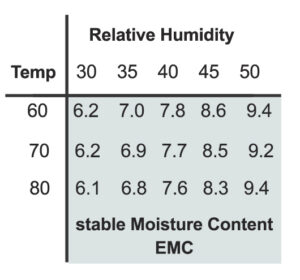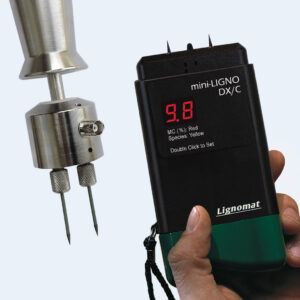Wood has always been sensitive to changes in moisture content. When its moisture content does not change, wood is stable. Then, shrinking, warping and other unsightly moisture defects will not occur. If cared for properly, woodwork can stay beautiful for a very long time. Click for more info on shrinking and warping.
Relationship between Stable Wood and Relative Humidity
Wood absorbs or loses moisture until it reaches an equilibrium with the surrounding air. For each relative humidity and temperature there is one specific wood moisture content at which wood remains stable and does not gain or lose any moisture. The equilibrium moisture content has been reached.

Example: Wood is stable at 7% and 35% relative humidity.
Wood is stable, when its moisture content (MC) is the same as the equilibrium moisture content (EMC). Click here for EMC chart for relative humidity values from 5% to 95%. Long-term dimensional stability and beauty of woodwork is only guaranteed when wood moisture content and the relative humidity of air stay within the values listed in the EMC chart. This chart applies to all wood species, whether you work with Red Oak, Cedar, or Mahogany.

Example: At 65% relative humidity wood absorbs moisture until 12% MC has been reached.
For example, if you expose a wood floor with a moisture content of 7% to a relative humidity of 65% for an extended period, the floor planks will absorb moisture until they reach 12%. On the other hand, if you use airdried lumber at 14% to build furniture for your home with an inside relative humidity of 35%, the wood will dry down to 7% and shrink and warp! To avoid moisture problems, use a moisture meter to check if wood has the correct moisture content before you start with your project.
Once the EMC has been reached and relative humidity and ambient temperature are not changing, wood is stable. Ideal conditions have been reached – wood will not shrink or warp.
Stability of Wood Above and Below Fiber Saturation Point.
The Fiber Saturation Point (FSP) is around 25-30%. Above this point, not much dimensional change occurs, as the free water between the cell walls evaporates. Degrade and defects occur during lumber drying, when the wood moisture content falls below the Fiber Saturation Point.
Wood absorbs or loses moisture below the Fiber Saturation Point (around 25-30%), it swells or shrinks. To complicate matters, shrinking and swelling are often accompanied by warping, making moisture problems worse. See: Shrinking and Warping.
Difference between dry winters and moist summers:
- At 70°F and 75% relative humidity, wood moisture will reach 14%.
- At 70°F and 35% relative humidity, wood moisture will reach 7%.
- At 70°F and 20% relative humidity, wood moisture will reach 4.5%.

Critical in-door relative humidity conditions for stable wood moisture.
If you place wood pieces with varying moisture contents (some drier, some more humid) in a constant climate of 70°F and 35% relative humidity, all pieces will end up with a moisture content of 7%, regardless of wood species or initial moisture content. Since in-house conditions are usually between 30-50% relative humidity, the magic moisture content for stable wood, furniture and hardwood floors inside a building is 6-8%. See also EMC graph.
Predicting Wood Stability
To determine if wood will absorb moisture, keep its moisture content , or loose moisture, compare wood moisture content, relative humidity and ambient temperature with the EMC Chart. To accomplish this task, you will need:
– A moisture meter to measure the wood moisture content.
– A thermo-hygrometer to measure relative humidity.
– The EMC Chart to find the corresponding EMC for the relative humidity of the surrounding air.
Wood does not shrink or warp when the wood moisture content and the EMC of the surrounding air are the same. Wood is stable.
The Internet lists more EMC values and the corresponding relative humidity and temperature values:
www.EMC Calculator.com
Lignomat Pin Meters

Pin meter to check if surface and core have the same moisture content.
Lignomat pin meters can measure all thicknesses from veneer to lumber to logs, from wet to dry, from flat boards to round or oddly shaped pieces. Lignomat mini-Ligno series have 7 different pocket-size models with built-in pins to meet your needs for moisture range, materials to be measured, number of wood group corrections and budget. We offer electrodes (hand probes) with insulated pins for wood and other materials and extension cables for in-kiln moisture monitoring, for restoration jobs or for building surveillance. Ligno-VersaTec and Lignometer moisture meters come with the widest measuring range, individualized wood species corrections, wood temperature corrections and calibrations for non-wood materials. The LCD display shows the measured moisture value with 0.1% resolution for the entire range and indicates wood species and wood temperature settings.
Lignomat Pinless Meters

Pinless dual-depth moisture meter Ligno-Scanner SDM
Lignomat pinless meters are ideal for measuring boards, panels and floor planks as well as scanning for moisture problems in floors, walls and ceilings. You can scan large areas quickly, and no effort is needed to insert pins into hard wood. No pin holes are left, which is crucial when measuring finished products and wood floors. If measuring low moisture contents is part of the scope of the moisture meter, Lignomat’s pinless moisture meters measure lower moisture contents in hardwood than pin moisture meters. Pinless meters require a flat measuring surface. They work well on rough sawn or scrapped wood, however you cannot use Scanners on round for accurate measurements on round or oddly shaped pieces.
Data Logger for Moisture Content and Relative Humidity
Unique Data Logger measures moisture in wood and other materials plus relative humidity/temperature of air.
The new BL2/RH/MC Tracker from Lignomat measures ambient conditions and moisture content simultaneously. Allowing the user to see, how changes in relative humidity affect the moisture content of wood and other hygroscopic materials. You can even set an alarm which alerts when the relative humidity or temperature is exceeding or falling under preset limits.
The BL2 is a watchdog alarm for relative humidity and moisture in all types of buildings and flooring applications, for ware houses or during transport.

